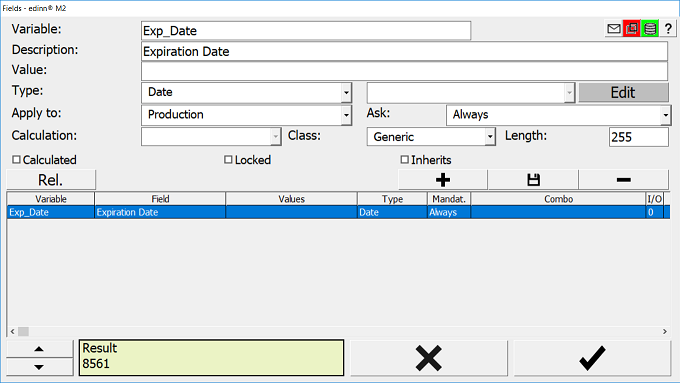Fields
You can access to this window by clicking the ![]() button.
button.
Defining fields allows to adjust the system to whatever the sector, no matter the particular need of information that sector has.
For example, let us imagine that there is an industrial sector which typically needs to:
- Indicate color and quality finish for every result it generates: therefore these specific fields can be created for the results grid.
- Take certain context data like temperature, tool used, etc. whenever a new task is performed: therefore these specific fields can be created for the autocontrol grid.
In the lower part: you will see a grid with the fields already configured, on which you can perform operations on the grid such as Insert, Save or Delete.
In the upper part: you will see the configuration of each record, where you can configure the parameters of a new insertion or edition.

CONFIGURATION PARAMETERS:
- Variable: internal name of the field. Allows to carry out statistical studies, links with algorithms (types of calculation), etc. You can change the description (field) field, but not the variable name.
- Description: literally that appears to the working user.
- Value: default value or the possible answers that the user could give (separated by commas).
- Type:
- Real: number with decimals.
- Integer: number without decimals.
- Date: date in the dd/mm/yyyy format.
- Time: time in the hh:mm format.
- Text: free text.
- IP Address: IP network address.
- Time Secs: time in hh:mm:ss format
- Selection: allows to make a drop-down menu. Use the combos configuration window to configure options.
- URL: url upon the system syntax. Please see how to configure URLs.
- Alphabetic: only letters.
- Date and time: dd/mm/yyyy hh:mm format.
- Date and time (secs.): dd/mm/yyyy hh:mm:ss format.
- Mult. Selection: multiple selection.
- MAC: MAC address.
- Percentage: number for percentages.
- Autoincrement: unique numeric value for the field independent of the result or task to which it is associated.
- Button: calls a function declared in a field management UDL.
- TCP port: TCP port between 1 and 65535
- Now date: current date in dd/mm/yyyy format.
- Now time: current time in hh:mm format.
- Now time (secs.): current time in hh:mm:ss format.
- Now date and time: current date and time in dd/mm/yyyy hh:mm format.
- Now date and time (secs.): current date and time in dd/mm/yyyy hh:mm:ss format.
- E-mail: Email address.
- For the cases of type Selection or Multiple selection: the next field is a drop down combo to indicate that the values of the field must be chosen from a predefined combo (list). The Edit button allows to create this combo lists.
- Apply to: indicates to what this field should be apply (Production, Inputs, Outputs, I&O [Inputs and Outputs], etc.).
- Ask: when the field is mandatory. The options are the following:
- When configuring fields for results:
- If empty: only if empty.
- Always: the field is always mandatory.
- Never: the field is never mandatory.
- On manual results: when results are being inserted manually.
- On finish: when finishing or pausing a order. This option will only apply for fields on inputs.
- On start: when starting an order.
- When configuring fields for autocontrol:
- Never: never is mandatory.
- Status change: when the status of the task changes.
- OK: if the task status is changed to Ok.
- Warning: if the task status is changed to warning.
- Error: if the task status is changed to error.
- Error or warning: if the task status is changed to error or warning.
- On start: when the task is started.
- Calculation: calculation type to be applied to the field. This is useful to convert the values of the fields.
- Class: this is to indicate to other computer systems the type of the field. Please see integration with other systems.
- Generic: General purpose field class.
- Unit of Meas.: Unit of measure. If informed, prevails over the unit of measure of the process.
- Cycle T.: Cycle time. Is informed, prevails over the one of the process and the PSR relation.
- Cycle Q.: Cycle quantity or cycle units. Is informed, prevails over the one of the process and the PSR relation.
- Lot: inform about the material lot.
- Enterprise: stores the corresponding B2MML tag.
- Site: stores the corresponding B2MML tag.
- Area: stores the corresponding B2MML tag.
- ProcessCell: stores the corresponding B2MML tag.
- Unit: stores the corresponding B2MML tag.
- ProductionArea: stores the corresponding B2MML tag.
- WorkCell: stores the corresponding B2MML tag.
- ProductionUnit: stores the corresponding B2MML tag.
- StorageZone: stores the corresponding B2MML tag.
- StorageUnit: stores the corresponding B2MML tag.
- WorkCenter: stores the corresponding B2MML tag.
- WorkUnit: stores the corresponding B2MML tag.
- EquipmentModule: stores the corresponding B2MML tag.
- ControlModule: stores the corresponding B2MML tag.
- Equivalence: every production counting is equivalent to how many pieces. For example: 1 unit (a box) is equivalent to 6 pieces.
- Unit Conversion: visual conversion from production units to visual units.
- Length: maximum length of the field.
- Calculated: indicates if the field will be calculated by a UDL.
- Locked: indicates if the field cannot be changed by the user.
- Inherits: indicates if the field inherits its value from the field with the same variable name of the previous production record.
- Rel button: relates fields.
- Field to relate
- Value for the specific relation.

